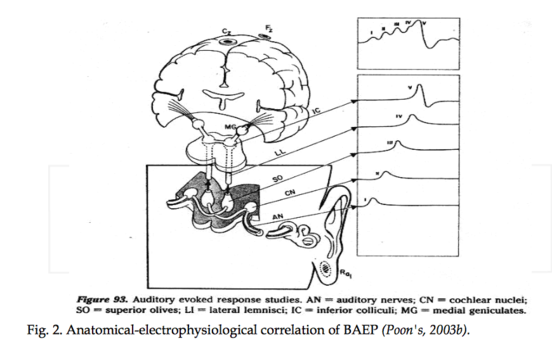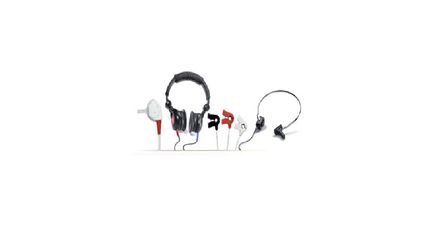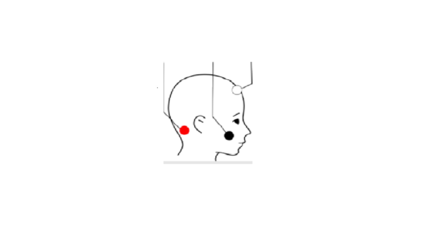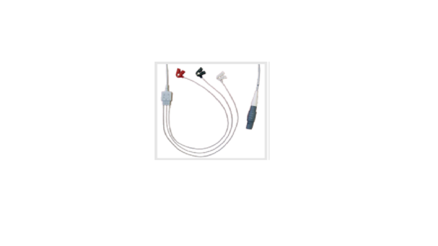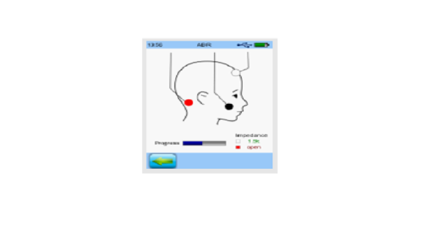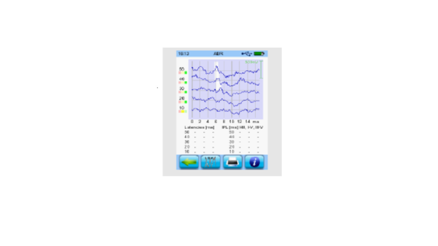Evoked potentials (2. LF UK)
(Redirected from Evoked Potentials Practical (Group 5))
|
Check of this article is requested. Suggested reviewer: Carmeljcaruana |
Evoked Potential Practical:[edit | edit source]
Introduction:[edit | edit source]
Evoked Potentials are electrical activities that occur in the neural pathways and structures as a response to external stimulations by light, sound, electricity or other stimulations. Evoked potentials are polyphasic waves (having more than two phases) that often present with an amplitude between 0.1-20 microV which are formed within 2-500 ms of an external stimulus.
Evoked potentials are used to show abnormalities in the function of nerve pathways that can be caused by neurological disorders. Examining evoked potentials can help us understand how quickly and completely the nerve signals reach the brain, help define the anatomic distribution, monitor pathophysiology of a disease, and reveal changes in a patient’s neurological status.
There are three major types of evoked potentials used in clinical studies: Visual (VEP), Brainstem Auditory (BAEP) and Somatosensory (SSEP) Evoked Potentials. In this experiment we will only make a point on Brainstem Auditory Evoked Potentials (BAEP). Brainstem Auditory Evoked Potentials are the potentials recorded from the ear and vertex in response to a brief auditory stimulation to assess the conduction through the auditory pathway to the mid-brain.
Importance in Clinical Medicine:[edit | edit source]
- To assess the function of the nervous system
- To aid in the diagnosis of nervous system lesions and abnormalities
- To monitor the progression or treatment of degenerative nerve diseases
- To monitor brain activity and nerve signals during brain or spine surgery, or in patients who are under general anesthesia
- To assess brain function in a patient who is in a coma
Brainstem Auditory Evoked Potentials:[edit | edit source]
On applying auditory stimulus to one ear, activation of peripheral and central auditory pathways occurs. Brainstem auditory evoked potentials (BAEPs) are the electrical activities resulting from the activation of the eighth nerve, cochlear nucleus, tracts and nuclei of the lateral lemniscus and inferior colliculus.
Classical BAEP consist of 5-6 vertex positive peaks. The initial five peaks are of clinical interest. Peaks 6-8 are variable and mostly used in clinical psychology. The important features useful in the recognition of different waveforms are as follows:
On the graph you can see waves, which were detected from these anatomical areas:
1 wave: distal action potential of acoustic nerve
2 wave: ipsilateral proximal acoustic nerve(or/and cochlear nerve activity)
3 wave: ipsilateral superior nucleus olivarius activity
4 wave: lateral lemniscal nuclear or axonal activity
5 wave: inferior colliculus activity (mesencephalic)
6 wave: medial geniculate body activity (thalamic)
7 wave: thalamo-cortical projection activity (cortical)
Using BAEP we can indicate hearing loss, balance disorders, headaches, head traumas, tinnitus and etc.
BAEP assess conduction through the lower brainstem auditory pathways which are not readily accessible to other testing procedures. In clinical practice BAEP are used to investigate patients with possible multiple sclerosis, structural lesions of the brainstem and posterior fossa, intraoperatively to monitor integrity of the auditory pathways during neurosurgical excision of posterior fossa tumors, and as a guide to prognosis in post-traumatic and anoxic– ischaemic coma in the ICU. Occasionally hearing assessments are performed using electric response audiometry in patients who are unable to cooperate with formal audiometry.Abnormal results may also indicate brain injury, brain malformation, brain tumor, central pontine myelinolysis, speech disorders, atherosclerosis and etc.
Literature Review:[edit | edit source]
A brainstem auditory evoked potential (BAEP) is caused by an acoustic stimulus, i.e., some kind of a sound, usually a series of clicks. The acoustic stimuli are transmitted from an acoustic transducer in the form of either an inserted earphone or standard noise cancelling headphones. The stimuli generates a response, i.e., electrical signals, from the basilar region of the cochlea. The signal then travels along the auditory pathway from the cochlear nuclear complex to the colliculus (mid-brain). The cochlear nuclear complex carries information from the inner ear, the cochlea, and transmits it to higher regions of the auditory brainstem. The elicited waveform response is measured by surface electrodes typically placed at the vertex of the scalp and ear lobes. The amplitude, i.e., micro-voltage, of the signal is averaged and graphed against the time, in milliseconds. The graphs ('waves') are recorded on an electroencephalogram (EEG) and examined. The waveform peaks, typically labeled I-V, usually occur within a 10-millisecond time period after an acoustic stimulus. Waveform I-II correspond to true action potentials, later waves may reflect activity in major brainstem auditory centers. The positive waveform peaks reflect combined sensory activity from axonal pathways in the auditory brainstem. BAEP is a useful tool to evaluate conduction through the brainstem and the auditory nerve pathways that are not accessible by other testing procedures. For example BAEP is used to assist in the diagnosis of hearing loss as well as detecting tumors and multiple sclerosis. BAEP also has the ability to inform about lesions affecting the auditory nervous system.
Despite the advantages that Evoked potential provides, advancements in visual imaging limits the use of evoked potentials. Magnetic resonance imaging (MRI) today provides more benefits than Evoked potential (EP) about structural anatomical issues and the EEG provides more information regarding the physiology of the anatomical pathways. However, BAEP provides a more cost effective choice and can also be used in the monitoring of patients during neurosurgery and sometimes in the intensive care unit (ICU).
The BAEP testing procedure is painless and side-effects are very rare. The most common side effect is skin irritation, often by either the gel or the electrodes themselves. The degree of the irritation depends on the patient. But many factors may influence the evaluation of the response given, factors like hearing loss, assymmetry of hearing loss, test parameters, distractions and other patient factors. These factors must be factored in when performing and analyzing BAEP results.
Equipment:[edit | edit source]
Listed below is the equipment necessary for a BAEP test:[edit | edit source]
1) Alcohol
2) Eletroconduting cream
3) Machine to record brainactivity (Path Medical Sentiero// Advanced SOH06)
4) Headphones and electrodes to record brain activity
5) Example of the examination
Examination[edit | edit source]
The Equipment that is used for the Evoked Potential experiment is the Path Medical Sentiero // Advanced SOH06.
The Electrodes should be attached as shown:
Prepare the skin by wiping (using alcohol) the areas where the electrodes will be placed .
Place electrode patches on these areas.
Attach the electrode clips to the electrode patches, according to their color.
Insert the ABR cable into the white jack of the machine. Place the electro-acoustic transducers (headphones) on the patient, making sure the red side is on the patients right ear and the blue side is on the left ear.
Turn the device ON (pushbutton on the right side).
Icons:
Enter patients name and details.
Advise the patient to lay as comfortably as possible and to avoid any muscle activity.
Press “ABR”(Auditory Brainstem Response).
Then choice TEKY
Verify the parameter settings settings (Tools icon):
- Stimulus – Chirp
- Polarity – Alternating
- Masking noise – yes
- (green arrow down = next screen):
- Levels [dB nHL] - two collumns: 70, 50, 30
- (green arrow down = next screen)
- Stimulus Rate – 20.1 Hz
- Averages – 1000
- (green arrow down = next screen):
- Automatred wave 5 detection
- Auto proceed
- Noise Stop Criterion: 10 nV
- Min wavw 5 Amplitude> 20 nVpp)
- Artifact Treshold: 20 μV
- (green arrow down = next screen):
- Age group: Adult
- OK
Choose which ear will be tested.
Electrode Impedance is checked before BAER measurement is checked.
When this is complete the play button will appear. Press this button to start the measurement.
When the BAER has been measured, the results will be displayed as shown below:
The results of a person with normal hearing should look like this:
The stimuli range between 10-50 dB HL.
As the stimulus levels decrease the Wave-V latency increases and the Wave-V amplitude decreases. The ABR is measurable down to 10 Db nHL. This shows that Wave-V latencies are within normal range.
On the other hand, the result of a person with Conductive hearing loss will appear as follows:
The Stimuli range between 40-80 dB HL.
The Wave-V latency is increased but out of normal Wave-V latency range. ABR threshold is reached at50 dB nHL, which corresponds to the hearing loss at high frequencies.
Press “Enter" to save results and to go back to regular ABR screen display. Record results.
Take the electrodes and cables off but keep the device switched on.
Mira[edit | edit source]
Mira is a program for evaluating measured curves.
- Run the Mira program on the PC.
- Login name: admin
- Password: 1234
- Connect the Sentiero device to the mini-USB cable.
- Click on Receive data
- Find the patient
- Mark the waves I, II, III for every stimulus intensity (70, 50 a 30 dB nHL)
- Fill in Comments
- Click on Print (Mira Print Preview)
- Print selected Test
- Fill in Examiner
- File
- Export document
- PDF file (ABR Detail Report)
- OK
- PDF file (ABR Detail Report)
- Export document
- Save the file
- Upload the Report on moodle
Conclusion:[edit | edit source]
The Brainstem Auditory Evoked Potential (BAEP) proves to be a non-invasive and a less costly method of assessing the functionality of the auditory nerve, cochlear nucleus, superior olive, and inferior colliculus of the brainstem compared to its counterpart MRI. The test is commonly conducted by the use of simple auditory stimuli or "clicks." Although this test has been exceptionally successful in detecting complications such as hearing loss, acoustic neuroma, multiple sclerosis, sub-arachnoid inflammation, and many other neurological disorders, it doesn't provide any solid information on how speech sounds are actually processed. A new method of testing undergoing research, Complex Auditory Brainstem Response (cABR), involves the usage of speech noises or music instead of the old-fashioned "clicks." This new method opens the door to a deeper understanding of the effects of peripheral hearing loss on speech processing in people with auditory processing problems and a stronger understanding of acoustic-based hearing complications.
Reference List:[edit | edit source]
- “Electrophysiology - From Plants to Heart” edited by Saeed
Oraii, 2012.
- Anbar, Michael & Spangler Robert A & Scott Peter
“Clinical Biophysics”, Warren H. Green, 1991.
- Chiappa, Keith H. “Evoked Potentials in Clinical Medicine 3d
edition”, Lippincott-Raven Publishers, 1997
- Walsh, P., Kane, N., Butler, S.. (2005, June). The clinical role of evoked potentials in Journal of Neurology, Neurosurgery & Psychiatry. Vol. 76,↵suppl. 2. ISSN: 1468-330X http://jnnp.bmj.com/content/76/suppl_2/ii16.full
- Kouni, Sophia N , Constantinos Koutsojannis, Nausika Ziavra, and Sotirios Giannopoulos. "A Novel Method of Brainstem Auditory Evoked Potentials Using Complex Verbal Stimuli." NCBI. U.S. National Library of Medicine, 6 Aug. 2014. Web. Dec. & jan. 2016. <https://www.ncbi.nlm.nih.gov/pmc/articles/PMC4158652/>


